2 Southwest Asia
The Southwest Asian region holds huge markets, including that of India, and has enormous economic potential. It is also a strategically important region for realizing a “Free and Open Indo-Pacific (FOIP)” because of its location on land routes and sea lanes that connect East Asia with the Middle East.
At the same time, the Southwest Asian region still faces many issues that must be addressed, including infrastructure development, development of primary education as well as healthcare and medical systems, establishment of the legal system, and response to natural disasters. In particular, poverty reduction is a major challenge, with approximately one-third of the world’s poor said to be living in this region. Note 10
● Japan’s Efforts
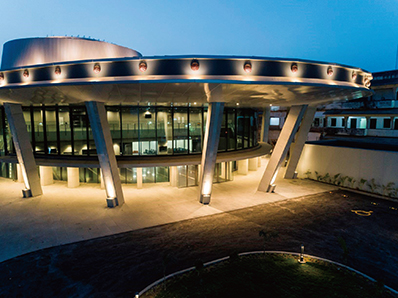
The Varanasi International Cooperation and Convention Centre in India, which was built with Japan’s support (Photo: JICA)
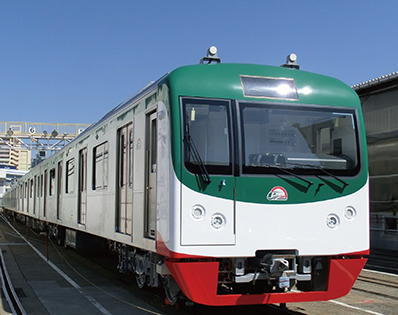
Dhaka City’s mass rapid transit (MRT) that is under development with support from Japan. The train cars, with the national flag of Bangladesh in its design, run through the city and support people’s daily lives. (Photo: JICA)
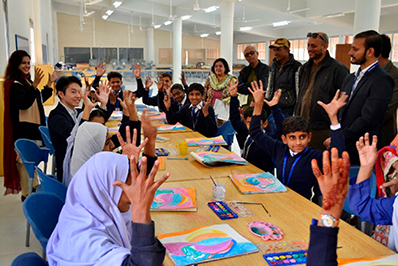
Students interacting in sign language at a special needs school for people with hearing impairments in Pakistan, where equipment was provided through Grant Assistance for Grass-Roots Human Security Projects

The Deputy Director of Health Centers in Nepalgunj City and a project manager discussing COVID-19 countermeasures as part of the COVID-19 Response in Emergency Project, “COVID-19 Response in Emergency (CORE) project in South-Western Nepal Providing Medical Equipment and Commodities” by the Japan Platform (Photo: ADRA Japan)
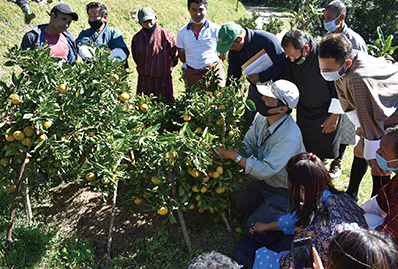
A JICA expert providing guidance on fruit tree fruiting management during training for the Integrated Horticulture Promotion Project in the West Central Region in Bhutan (Photo: JICA)
Japan provides a wide range of assistance in order to harness the economic potential of Southwest Asia as well as to reduce disparities between the rich and the poor.
In 2021, in regard to the response to COVID-19, as of December 2021, Japan has provided approximately 7.73 million doses of domestically produced vaccines to Bangladesh, the Maldives, Nepal, and Sri Lanka through the COVAX Facility. Note 11 In addition, Japan provided emergency grant aid to Bhutan, India, the Maldives, Nepal, Pakistan, and Sri Lanka for the development of cold chains as “Last One Mile Support” to establish a vaccination system, and provided medical equipment such as ventilators to India where infections have spread rapidly since April 2021.
Furthermore, Japan provided COVID-19 Crisis Response Emergency Support Loans of ¥30 billion and ¥40 billion respectively (see Part I for emergency assistance to address the rapid spread of COVID-19 in India) in order to provide financial support for the crisis responses in India and Bangladesh affected by the spread of COVID-19. In addition, Japan has taken debt relief measures for the Maldives, Nepal, and Pakistan in accordance with the Paris Club Note 12 agreement on the response to COVID-19.
In recent years, India has been one of the largest recipients of Japan’s ODA loans, and Japan has provided assistance to India for the development of economic and social infrastructure, including in the fields of electric power and transport, which would contribute to enhancing connectivity and strengthening industrial competitiveness, improvement of the investment environment and human resources development. In addition, in support of its sustainable and inclusive growth, Japan has played a significant role in India’s growth through support to various fields, such as support to the forestry sector with an aim to improve livelihoods, development of health and medical systems, and poverty reduction measures.
In March 2021, Japan provided a total of seven ODA loans totaling approximately ¥276 billion, including projects for the construction of metro rails in Delhi, Bengaluru, and Kolkata, road construction to improve connectivity, and development of agricultural production infrastructures to increase farmers’ incomes.
In addition, the opening ceremony of the Varanasi International Cooperation and Convention Centre, which had been constructed with Japan’s support, was held in July 2021. Then Prime Minister Suga delivered his congratulatory message through video on the completion of the Centre and expressed his hope that it would become a new symbol of friendship between Japan and India. Furthermore, during a summit meeting in September 2021, Japan and India confirmed they would cooperate toward the steady progress of the development plan for the Mumbai-Ahmedabad High Speed Rail (MAHSR). After the plan is completed, it is expected to shorten the travel time between Mumbai and Ahmedabad, which is currently at least seven hours by express train, to two hours, and the train fare is expected to be roughly half of that of the corresponding airfare.
With regard to Bangladesh, where there has been remarkable growth and an increase in the number of Japanese companies operating business in recent years, Japan seeks to further advance the Japan-Bangladesh Comprehensive Partnership and promote development cooperation under the “Bay of Bengal Industrial Growth Belt (BIG-B)” initiative. The three pillars of the initiative are: (i) development of economic infrastructure, (ii) improvement of the investment environment, and (iii) enhancing connectivity. In November 2021, in addition to the above-mentioned COVID-19 Crisis Response Emergency Support Loan, Japan provided three ODA loans totaling approximately ¥292 billion to Bangladesh, including for the “Dhaka Mass Rapid Transit Development Project (Line 1) (Phase 2)” to support the improvement of connectivity and economic infrastructure development. In December of the same year, Japan also provided grant aid totaling approximately ¥2.9 billion for two projects for the human resources development of young government officials who will shoulder the future of the country.
Regarding displaced persons from Rakhine State, Myanmar, Japan has expressed its appreciation to the Government of Bangladesh for accepting the displaced persons for a prolonged period of time, and stated that Japan will continue its support, including reducing the burden of host communities, at foreign ministers’ meetings and other occasions. Japan also provides various forms of support to benefit the host communities and displaced persons. Assistance newly approved in 2021 by Japan includes grant aid through international organizations to improve water supply and distribution systems and strengthen health and medical systems. Additionally, Japan provides support through the Japan Platform (JPF) for Japanese NGOs to deliver life-saving humanitarian assistance including distributing food and non-food items to survive, improving hygiene and sanitation, providing medical treatment, and protecting women and children (see “Japanese Personnel at International Organizations Playing Active Roles on the Front Lines across the World amid the COVID-19 Pandemic” regarding the activities of Japanese staff at WFP, and “(3) Emergency Assistance to Address the Rapid Spread of COVID-19 in Asia” regarding assistance for India and Nepal through JPF).
Sri Lanka, which is located in a strategic position along sea lanes connecting Asia with the Middle East and Africa, has traditionally been a country that is friendly toward Japan. Japan works on strengthening cooperation between the two countries, particularly in the fields of enhancing connectivity through the development of infrastructure and maritime matters, toward the realization of a “Free and Open Indo-Pacific (FOIP).” Japan also continues to carry out assistance to cope with natural disasters and provides cooperation including for livelihood improvement as well as industrial and human resources development with a focus on the agricultural sector for regions that are lagging behind in development due to the impact of past conflicts. In 2021, Japan provided grant aid to support the socio-economic reintegration of Sri Lankan migrant workers repatriated due to the COVID-19 outbreak in collaboration with the International Organization for Migration (IOM).
The Maldives, same as Sri Lanka, is located in a strategic position along the sea lanes of the Indian Ocean. Japan works on strengthening cooperation between the two countries toward the realization of a “Free and Open Indo-Pacific (FOIP).” In 2021, Japan decided to provide grant aid for the construction of the Maritime Rescue Coordination Centre to strengthen maritime rescue and maritime crime response capabilities, the provision of a sea ambulance to strengthen health and medical systems, and agricultural promotion support to diversify the economy of the Maldives, the main industry of which, tourism, has been damaged by COVID-19.
With the world’s fifth largest population, and located at a geopolitically important point between Asia and the Middle East, Pakistan plays a vital role in the international community’s efforts to eradicate terrorism. The stable development of Pakistan is also important from the perspective of peace and stability in the surrounding region as well as the international community as a whole. In 2021, in addition to the grant aid to expand maternal and child health care facilities in Sindh Province for enhancement of the country’s health and medical systems, Japan provided grant aid to support vaccination for polio eradication in Pakistan, where, like in Afghanistan, wild strains of polio are constantly present. Furthermore, Japan supported the installation of a weather surveillance radar as well as the improvement of a water treatment plant and rehabilitation of the water transmission and distribution facilities through grant aid.
As a country that has traditionally friendly relations with Japan, Nepal’s firm establishment of democracy, as well as its stability and prosperity, are important for Japan to ensure the stability of the entire Southwest Asia region, which is also politically and economically important to Japan. After the major earthquake in Nepal in 2015, Japan has promoted “Build Back Better” in the country. In December 2021, the International Conference on Nepal’s Reconstruction 2021 was held in Kathmandu, where Parliamentary Vice-Minister for Foreign Affairs Honda provided a video message introducing how Japan has contributed to Nepal’s reconstruction based on its experience and lessons learned from natural disasters. Through Japan’s assistance, bridges, hospitals, and other public infrastructure facilities have been completed, as well as housing (approximately 85,000 in total) and schools (approximately 210 in total) by October 2021. Additionally, Japan also provides a range of technical support related to strengthening the government’s disaster risk reduction capabilities and the widespread adoption of buildings in line with construction standards. Moreover, in 2021, Japan provided grant aid for three projects, including the improvement of medical equipment in advanced public hospitals in the country.
Japan’s development cooperation toward Bhutan has achieved steady results, especially in the improvement of agricultural productivity, development of economic infrastructure such as road networks and bridges, and human resources development and other fields. In 2021, Japan provided grant aid for the development of geospatial information necessary for disaster prevention measures and water source management.
BangladeshPublic nomination
(1) Capacity Building for Community-Based Disaster Risk Reduction (DRR) in Urban Areas of Bangladesh, (2) School-based Capacity Building for Enhanced Disaster Risk Reduction (DRR) in Dhaka North City Corporation (Phase 1)
(1) JICA Partnership Program (April 2016 – April 2019), (2) Grant Assistance for Japanese NGO Projects (March 2020 – ongoing)
Dhaka, the capital of Bangladesh, is experiencing rapid urbanization and population growth, and the risk of urban disasters such as earthquakes, fires, and flooding due to heavy rain has increased. However, not many citizens of Dhaka are aware of the importance of disaster risk reduction (DRR). For example, initial firefighting, calling the fire service and evacuation often do not take place promptly, and firefighters sometimes are blocked by curious crowds of people at the scene. These are actions that exacerbate disaster impacts that otherwise could have been minimized.
This urged SEEDS Asia, a Japanese NGO, to work on the enhancement of the disaster preparedness capacity of Dhaka’s community residents since 2016 together with Dhaka North City Corporation and through the JICA Partnership Program, as well as Grant Assistance for Japanese NGO Projects, towards the goal to build disaster-resilient people and communities.
Specifically, SEEDS Asia provided DRR training to the leaders of resident groups that were willing to take responsibility for DRR in their respective locality (e.g. condominium associations and youth groups, etc.). In addition, the preparation of each areas’ DRR plan was facilitated, through which a sense of ownership among the community residents was fostered, self-help and mutual help initiatives were developed, and DRR activities were incorporated into their daily lives. SEEDS Asia referred to the “Disaster Reduction Well-being Communities,” established in different areas of Kobe after the Great Hanshin-Awaji Earthquake, to design its activities. Through this project, 12 DRR communities were established in Dhaka.
Dhaka’s DRR communities continue and develop their activities to date. Their initiatives include not only DRR Town Watching for hazard map making and firefighting training, but also strengthening their network, sharing challenges faced and initiatives of each community, and concluding pre-disaster agreements for mutual aid. Furthermore, after the spread of COVID-19, the communities responded by swiftly installing simple hand-washing stations and rolling out food support, mask distribution, and awareness-raising activities.
Following the community-based engagement in DRR, SEEDS Asia initiated a new project for school-based capacity building for enhanced DRR in FY2020. The circle of DRR in Dhaka is expanding through the sharing of expertise of DRR communities with schools as experts of the localities, and all such efforts started from the lessons of Kobe.
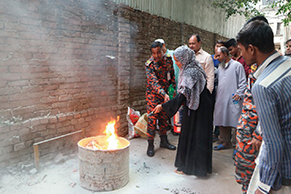
Firefighting training by a DRR community (Photo: SEEDS Asia)
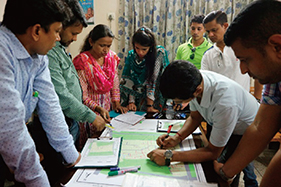
A Dhaka DRR community preparing a DRR Town Watching map (Photo: SEEDS Asia)
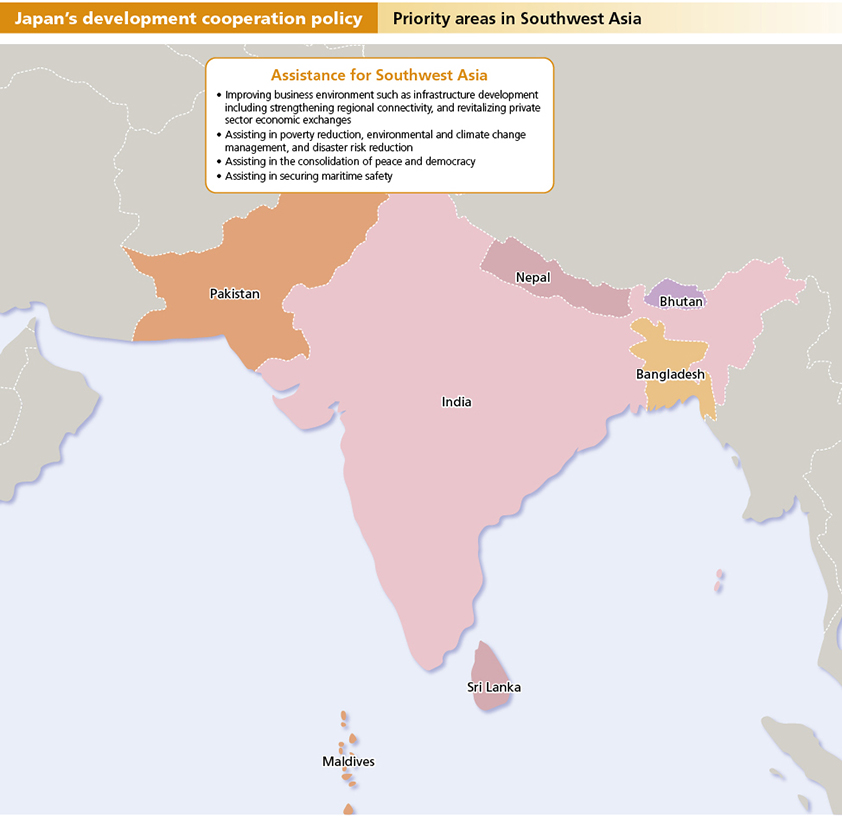
- Note 10: Source: World Bank website (note that Afghanistan is included in South Asia).
https://www.worldbank.org/ja/country/japan/brief/south-asia (in Japanese only)
https://www.worldbank.org/en/news/press-release/2018/09/19/decline-of-global-extreme-poverty-continues-but-has-slowed-world-bank - Note 11: See the glossary.
- Note 12: See Note 8.
